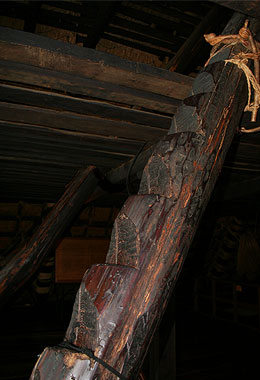| Lit. zig-zag ladder. A kind of ladder, hashigo ςq(see *kaidan Ki), made by cutting steps
directly into the surface of a single wide log or a wide piece of timber
or by affixing short horizontal pieces or wood to a log. Gangi hashigo
were used in the raised-floor rice storehouses takayuka souko °qΙ,
of the Yayoi period, and have been excavated at the Yamagi RΨ site in Shizuoka
prefecture. A more refined version of the ladder is also used at Gekuu Mikeden
O{διaa in Ise Jinguu Ι¨_{. It is mentioned also in an account of a vernacular
houses *minka ―Ζ, in
Akita prefecture, dating from 1785, where it is described as an old style.
Gangi hashigo survive in vernacular houses, in Aomori and Iwate prefectures,
where they are used to provide access to stable lofts. |



